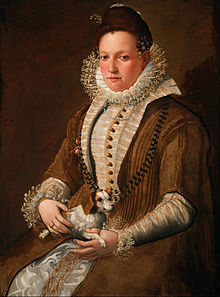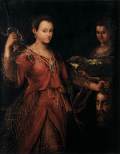Lavinia Fontana (1552-1614) is widely considered the first female artist of the modern world to have worked as an equal alongside her male counterparts. Born in Bologna, she was taught to paint in the then-popular Mannerist style by her father, a fairly minor artist. Fortunately for Lavinia, Bologna was a relatively open-minded city; it had admitted women to its university since it opened in 1158. Even for Bologna, though, Lavinia's marital arrangements must have stood out. In 1577 she married another painter, Gian Paolo Zappi, who was a rather ordinary artist but must have been a very unusual man for his time. He willingly subjugated his career to hers, becoming her assistant and agent as well as taking care of many household matters. Meanwhile, Lavinia supported the family. As far as I know, Gian Paolo was the first documented househusband in history, and I can only imagine how well that situation must have been received down at the bocce court. It was because of his generosity that Lavinia, who gave birth to eleven children (although, sadly, only three of them survived her), managed to continue to devote herself to her career.
By the late 1570s Lavinia had achieved a local reputation for fine portraiture, depicting upper-class members of Bolognese society.
Apparently female painters weren't unheard of at the time, but they were basically relegated to the "mommy track" of painting: portraiture. Most of her portraits were of wealthy people who could afford to pay commissions, but here's one more intimate one that I particularly like:
(Could this have been one of her children? I like to think so.)
What was different about Lavinia, though, was that she expanded her reach beyond portrait-painting into different genres. She began with small devotional works painted on copper, which were popular as gifts, and moved on to large-scale works on religious and mythological subjects.
Minerva Dressing
Judith With the Head of Holofernes
She was also commissioned to make many large altarpieces for the churches of Bologna. In 1603, at the invitation of Pope Clement VIII, Lavinia and her family moved to Rome, where she continued to succeed at her work and the family of Pope Gregory XIII became her patrons. Pope Paul V sat for a portrait by her. She received many honors for her work, and was elected to the Accademia di San Luca, a Roman artists' guild. All told, she painted 135 documented works, although only 32 signed and dated ones survive. One of her paintings, "Jesus Appears to Mary Magdalen," now hangs in the Uffizi Gallery:
Lavinia Fontana died in Rome in 1614. Her prolific body of work outlives her.






I love your blog name! Also love your challenge theme! I'm so illiterate when it comes to art, thanks for educating me!
ReplyDeleteThank you, Ronda! I don't know much about art either but I've learned a whole lot about many different subjects by researching some of these A to Z posts. I'm so glad other people are learning from them too!
DeleteI love this artist, but must admit I hadn't heard of her. That child does kind of look like her.
ReplyDeleteThank you so much for stopping by and leaving a note. I doubt many people have heard about her except for art historians and bloggers obsessed with the 16th century who are researching people to post about! (Guess which one of those I am.)
DeleteThat's amazing!
ReplyDeleteThank you, Tyrean! I'm so glad when people find the people I've been blogging about as interesting as I find them! It makes all the research worthwhile.
ReplyDeleteHouse-husband to 11 babies is no joke! Seriously, your posts are awesome educational. I never dreamed women anywhere were allowed to attend uni in the 12th century. How progressive!
ReplyDeleteNila: if there's one thing I hope to accomplish with this A to Z Challenge, it's to show that no matter how long ago the 16th century seems to us, people who lived then were just people, in all of their infinite variations. They could have been our friends, our neighbors, our heroes, our demons. They could have been us.
DeleteWow a man putting his wife's career before his and especially in that day and age. Amazing!
ReplyDeleteAgreed, Donna! Imagine how much guts that took for him. Thanks for visiting!
ReplyDeleteWow... what a cool post, and a very cool person. I think Gian Paolo rocks!! We could use a few more of him these days! :-)
ReplyDeleteYes, Gian Paolo should definitely have been cloned. On the bright side, there's still a family of their descendants, so his genes live on! Thanks for visiting.
DeleteLook at them tight buns. Hehe. What a brilliant artist!
ReplyDeleteShe really was, Tammy. I wish some of the reproductions I posted weren't so fuzzy, but that was the best quality I could manage to get. Thanks for visiting!
Deletequite a post, informative
ReplyDeleteThanks so much for stopping by! It took a lot back then for a woman to make it in a man's world, that's for sure.
DeleteI love learning about great women in history! Thanks for a great post!
ReplyDeleteThank you, Stephanie! And I still have a pirate queen waiting in the wings...
DeleteWow. You found the most interesting people for every letter :) Imagine that, popping out 11 kids while also having a professional career. In the middle ages. Kudos to her. And also to the husband :)
ReplyDelete@TarkabarkaHolgy from
Multicolored Diary - Epics from A to Z
MopDog - 26 Ways to Die in Medieval Hungary
Thanks for reading and stopping by! And may I say that there couldn't have been any more inventive ways to die or be killed in medieval Hungary than the ones you've assembled in MopDog. You go, girl!
ReplyDelete